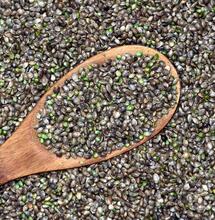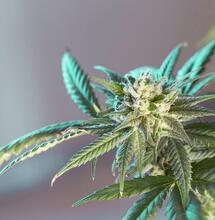Mutant Mary Jane
_70.jpg)
No, we're not referring to GMO weed, although that's worthy of scrutiny – but for different reasons. These mutants are merely the strange anomalies that seem to recur through various different breeding and selection practices, and in many cases there is no clear cause for their appearance. There are a handful – which various breeders across the world have attested to inadvertently stumbling upon – that have become relatively well-known, and occasionally established as strains in their own right. These include the creeper, huge-upright, whorled phyllotaxy, variegated, and web-leafed phenotypes, but no doubt there are a lot of others out there still to be found – or yet to evolve.
Ducksfoot 'webbed' Cannabis, developed by an elusive Australian breeder known as Wally Duck, is a classic example of a random mutation that has been cultivated into a true-breeding strain; when grown from seed all individuals exhibit the webbed phenotype, although there can be variation in cannabinoid content, bud structure and yield.
Ducksfoot is mostly sativa – although web-leafed indica strains have also been established – and efforts to grow it anywhere but outdoors in a sub-tropical or tropical location have proven disappointing. However, the seeds are no longer available and there are fears that the breeding program has stopped.
The large, splayed leaves closely resemble the feet of an aquatic bird, and are not immediately recognizable as Cannabis. The webbed trait is controlled by a recessive gene: it requires two copies of the allele to express, and if crossed with an ordinary compound-pinnate variety the Ducksfoot will produce non-webbed and webbed offspring in an approximate three-to-one ratio.
It is unclear where the first webbed Cannabis genetics originated – although there have been several Hawaiian examples over the years, usually more on the indica side of the spectrum. There are many indicas that exhibit a slight degree of webbing, particularly in very wide-leafed varieties, but entirely fused leaves are much more unusual.
Other interesting leaf mutations can also occur, and breeders are paying close attention to them all for their potential in stealth growing. The Australian Bastard Cannabis (ABC) – sometimes known as Dizzy, depending upon the breeder – is another true-breeding example, which apparently originated somewhere near Sydney.
The local growers who discovered wild populations of this apparently established mutation colloquially dubbed it 'mongy weed'. This singular plant has an appearance unlike any other form of Cannabis: the leaves are non-serrated, succulent and usually no greater than two inches in length, the overall structure is short and shrub-like, and the smell the growing plant gives off is faint.
Although the original strain is thought to be mutated ditch-weed with low cannabinoid content, efforts to cross it with more potent varieties have been occasionally successful. It has the added advantage of being extremely frost-resistant, and displays little of the hermaphroditism common in inbred wild populations.
The trait is recessive: crosses have yielded mostly 'normal-looking' plants, but the few F2 offspring that exhibit the trait have produced quality pot with a spicy taste and a euphoric sativa high. This is definitely a type of Cannabis to look out for in the near future, as it was discovered relatively recently and research is ongoing.
Another mutation that is of much interest to stealth gardeners is the creeper (or 'vine') phenotype – although it is possible to train most ordinary Cannabis plants to follow a similar growth pattern. Specimens typically grow upright at first; upon reaching a maximum of one meter or so in height, the main branches begin to bend strongly downward until they reach the ground. These branches may even form roots along points of contact with moist and mulch-y soils, which can boost the plant's productivity and eventual yield.
When flowering begins, the buds grow back up towards the light as normal, and usually become large, airy structures reminiscent of Thai or southern Indian strains. Creeper phenotypes almost always occur in cultivated sativas, due to their great height and abundant branching, and usually have large leaves with long, thin leaflets.
This mutation is highly sought after by growers who have height limitations, and as well as its stealth advantages one can usually expect a high yield due to the extra roots and increased supply of nutrients to the buds. Very little is known about the circumstances that lead to creeper mutations in Cannabis, and it is believed that it is not strain-specific.
The huge upright phenotype is another mutation that mostly occurs in cultivated populations, usually as a result of hybridization between certain indica and sativa varieties. There is very little information on this phenomenon, but it is thought to be most common in North American populations.
The structure of the plant is very similar to the Hindu Kush, with a tall, straight central stalk and a Christmas-tree shape, but the height is closer to that of the largest tropical sativas, at up to 13 feet tall. This mutation appears to be non-specific in origin, and a great deal more research is needed. But hybrid vigor is far from unknown, and it appears this may be merely one particular example of this phenomenon.
Extreme examples of hybrid vigor may occur as a result of polyploidy, rather than a specific set of gigantism-controlling genes – unlike dwarfism, which is a genetic trait that has been stabilized into true-breeding varieties on numerous occasions. Cannabis is normally diploid (i.e., it possesses two full sets of chromosomes); polyploid plants possess extra chromosome sets, and often exhibit greater size and yield potential than their diploid counterparts.
However, polyploid individuals usually cannot be crossed with diploid varieties (most are in fact sterile). If polyploid individuals are crossed together, subsequent generations will usually revert to diploid. Therefore, despite much initial furor surrounding their discovery, interest in breeding circles has somewhat waned. This is also due to the fact that polyploidy is an apparently random mutation, and the only way to artificially induce it involves the use of the toxic chemical colchicine, a tricyclic alkaloid that inhibits mitosis.
Usually, a healthy cell undergoing mitosis splits its chromosomes into two exact copies before dividing entirely; if colchicine is introduced at the point immediately before total division it will prevent it from occurring. The cell will remain undivided, with two full chromosome sets. However, plants treated in this manner do not all end up polyploid – the few that do are often sickly and non-viable.
There is speculation that the Australian Bastard Cannabis was actually the result of a colchicine experiment gone wrong, but there is no hard evidence. Furthermore there is little evidence to demonstrate beyond doubt that polyploidy is even a greatly desirable condition for Cannabis; while polyploids of other plant species such as wheat, oats and tobacco have exhibited increased vigor, quality and yield, it is not the case for all plant species.
However, there are reports of naturally-occurring (and even some artificial) Cannabis polyploids growing up to be large, beautiful and high-yielding plants, and we may well unlock the secrets to the process at some point. Another mutation, often mistaken for polyploidy, is whorled phyllotaxy.
This comparatively common mutation is not due to complete chromosome doubling as a result of arrested mitosis, but rather is controlled by variations of a gene or group of genes. 'Phyllotaxy' refers to the arrangement of leaves on the stem: Cannabis begins life with decussate (opposite and perpendicular) phyllotaxy, developing into an alternate pattern with the onset of flowering.
A whorled pattern refers to an arrangement of three or more leaves on each internode rather than the usual two; usually a triple or 'trilateral' pattern (erroneously termed 'trifoliate', whereas this term applies to a compound leaf with three leaflets), with the three leaves arranged at equal 120-degree angles around the stem, although four-leafed patterns have been observed. Whorled plants usually occur randomly and often revert back to decussate on attempts to achieve true-breeding strains – although there are claims that stable strains are in the pipeline. There is no apparent consensus on whether whorled phyllotaxy is good or bad, but breeders generally accept that it is usually unlikely to hinder the plants, and most will probably end up male.
Some claim higher yields from whorled female plants, due to the extra bud sites and increased ability to photosynthesize, but this is purely anecdotal. Perhaps the most striking mutation to occur in Cannabis is variegation, where the genes that control chlorophyll production do not fully express, and the buds and leaves develop streaks and patches of pure white, due to the lack of pigment. Lack of chlorophyll prevents photosynthesis, so fully-albino Cannabis specimens with dual faulty or 'switched off' copies of the gene that controls its production do not usually survive long, although they do occur. Those that have one working copy of the gene can exhibit stunning patterning – even leaves that are exactly divided along the length, half white, half green.
It is thought that variegated Cannabis is generally not as potent or high-yielding as fully green varieties, due to its reduced ability to photosynthesize. However, there has been some success with breeding programs, and there are a few seed strains available today (such as some from DJ Short) that will produce a percentage of variegated specimens. There are growers out there who will testify as to the amazing quality of their variegated pot, although it is generally accepted that yields are low, and growth slow.
Although there may be exceptions, variegation in plants mostly occurs as a result of cytoplasmic inheritance, which differs from normal chromosomal inheritance. The cytoplasm of the cell contains its own set of extra-chromosomal genes, which do not adhere to the rules of Mendelian inheritance as chromosomes do. In normal reproduction of Cannabis, the male parent provides just a nucleus to the zygote (the newly fused sperm and ovum), and the female parent provides the remaining needed genetic material, including the cytoplasm itself. For this reason variegated genetics are passed down by the mother only; male pollen from variegated plants will not replicate the trait in their offspring.
To add further complexity, seeds taken from the female plant will exhibit traits according to where on the plant they are found. Seeds from all-white sections produce white, non-viable plants, seeds from the green section are normal, and seeds from variegated sections gave varied results: some normal, some white, some variegated.
It is unclear if variegation in Cannabis is cytoplasmic, but the fact that available strains claim around 15% variegated plants gives credence to the theory. It is clear that further research needs to be done, and it is ongoing – the excitement generated by the few successful grows shows that demand for such genetics would be high.
The list of known Cannabis mutations does not end here: purpling, crinkled leaves, conjoined twins, buds that grow on fan-leaves... whether spontaneous or artificially-induced, these mutations testify as to the astonishing variability of this unique species. There are many potential uses for mutated strains, beyond those for stealth growing and increased yield, and as we learn more about their nature and occurrence we will simultaneously learn much about what they can do for us from a medical and recreational viewpoint.
Breeders seeking to artificially induce mutations must exercise caution, as we could inadvertently create undesirables that will spread and dominate our existing strains. This is unlikely, as most true mutations have been unable to spread far on their own; however, the speed at which we have seen temperate indicas invading the sativa-growing regions since their introduction shows that we must take steps to limit genetic overlap in the wild.
Limiting such experimentation to an indoor setting is the responsible option, and breeding for traits rather than forcing them to appear with chemical use is kinder to the plant. That said, good luck to the mad scientists among our readers – now let's see what else we can come up with.



